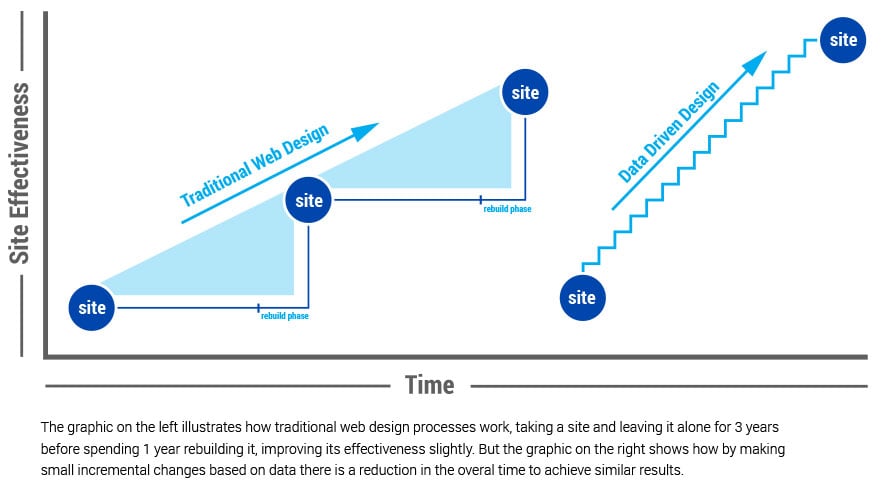Understanding how a business benefits from Data Driven design begins with what the term “Data Driven Design” means. Referencing Invision, “Data-Driven design is about using information gleaned from both quantitative and qualitative sources to inform how you make decisions for a set of users.” It is important to understand that designers (product, website and otherwise) are not typical users, and data driven design is important because it allows designers to see past their personal biases - utilizing analytics (quantitative) and anecdotal (qualitative) evidence.
In order to explain how a business benefits from data driven design, we are going to go into some of the most common myths arguing against data driven design and how a different approach can mitigate these issues. If you're already sold and want to jump in and see how you can get started with data driven design visit our growth-driven design checklist.
That Sounds Expensive - The Cost Argument
“We’d love to do UX, but it's too expensive” - Every Client Ever
In traditional web design this can be a pretty accurate statement - if there is no data that has been collected a team could potentially need to wait 30 to 60 days to collect a meaningful amount of data through analytics and even more if they are trying to conduct user interviews or surveys. This means paying for a group of people to facilitate and collect data - when what you really want to pay for is a website. That means finding a different approach to build websites and digital experiences.
Utilizing a growth driven design framework to create a website means starting with a more targeted experience (with a launchpad website) and using user data, analytics and screen recordings to iterate and craft digital experiences that convert. From HubSpot, “Growth-Driven Design is an investment that produces reliable month-over-month growth. Your website becomes stronger as you continue to measure, iterate and act.” Not only does this process deliver a strong return on investment (ROI), it provides a new website up-front that is the base for the iterative process.

So to respond to the “cost argument” - it can be expensive, but by utilizing a Growth Driven Design approach the large up-front cost can be mitigated, and by using user data (through analytics and screen caps) the website can evolve based on user preferences. This leads to more conversions and a bigger ROI.
That Sounds Like a lot of Work - The Time Argument
The other argument that we hear pretty often is, “We’d love to do UX, but this will take too much time, I need a new website NOW,” and if you’re operating in the traditional website process mindset this can be true - waiting 60 days to collect data before even launching into a website build can be hard to swallow. But here again, we can lean on the fundamental principles of growth driven design.
Creating a launchpad website is a quick process that produces a iteration-ready website that can immediately help your business. Referencing HubSpot, “The goal of the Launch Pad website is to quickly build a website that looks and performs better than what you have today, but is not your final product. Your Launch Pad is the foundation from which you collect real-user date and optimize.” Once the launchpad is completed it becomes easily to implement data driven design, focusing on the elements of the site that drive conversions and results for the business. This can be done in bite-size fashion, improving and growing sections of the site as user preferences are determined through data.
When it comes down to countering the “time argument,” it's about breaking down the project into several phases, each providing value and results for the business. When using growth driven design a team is able to provide more immediate value, improving on a platform that is already delivering conversions.
Our Customers don't Care About UX - The Usability Argument
Another myth we hear pretty frequently is that either “our customers don’t care about UX” or the “I know what our customers want, so I don’t need data,” myths. Even designers, who are trained in the use of empathy and spend their careers trying to develop meaningful experiences for their clients can’t create designs with 100% accuracy. As InVision puts it “Even the best designers in the world can’t predict exactly what users want; we are rarely (if ever) the target audience. Learning what makes your users tick and ensuring your product solves their needs is paramount to your product’s success.”
Data is the bridge between your company and your customers, it provides insight as-to what content they find valuable and what problems they are coming to you to solve. You may think that your customers don’t care about UX, but what they actually care about is being served in the most convenient way possible, they want to use digital products that seem intuitive - products that seem to anticipate what they are looking for and provide it to them. These easy-to-use experiences are driven by an understanding of user data.
So How Does My Business Benefit from Data Driven Design?
Businesses exist because they provide a product or a service to their customers and data driven design is the methodology that crafts digital experiences that provide the most value for their users. By using a non-traditional methodology (like growth driven design), the stereotypical drawbacks (the cost and time investment) of a website project can be mitigated. This process relies not on designer instincts, but on website analytics and user data, meaning at every turn the website can add value to the customer’s experience. All of this translates into more conversions and higher ROI for your business.
